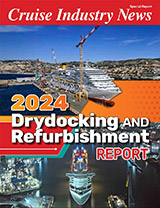With a call by Ponant’s Le Bellot, the Detroit/Wayne County Port Authority and Cruise the Great Lakes marked a record-breaking $125 million 2022 cruise ship season for Detroit and the Great Lakes region, according to a press release.
“This year we welcomed 52 cruise ship dockings here in our city, which is more than double our last cruising season in 2019,” said Mark Schrupp, executive director, Detroit/Wayne County Port Authority.
“Visit Detroit has been a key partner in helping to publicize to cruise lines and passengers places like the Henry Ford, Motown and Charles Wright Museums, as well as our world-class art institute, the DIA and many more.”
According to the Detroit/Wayne County Port Authority, 2022 was a record-breaking year for Great Lakes cruising, with nearly 150,000 passenger visits to Great Lakes ports, an increase of more than 25 percent from the previous cruising season, producing an economic impact of more than $125 million.
Cruise the Great Lakes expects nearly 170,000 cruise passenger visits to regional ports in 2023, up 15 percent from this year.
“The broader regional success of Great Lakes cruising is represented right here in Michigan,” said Dave Lorenz, Vice President of Travel Michigan and Chair of Cruise the Great Lakes. (pictured above) “This year, cruises visited places like Houghton, Mackinac Island, Muskegon, Holland, Sault Ste. Marie and, of course, Detroit. Destinations like these are the reason why Condé Nast Traveler named Great Lakes cruising as one of its top 22 travel destinations of 2022.”
The Viking Polaris and the Hanseatic Inspiration are expected to call in the area next year, bringing the total number of cruise ships on the Great Lakes to 11, a more than 20 percent increase year on year.
The total economic impact of Great Lakes cruising is estimated to be $180 million in 2023.
In addition, the governors of the Great Lakes region have joined forces with the American Great Lakes Ports Association and the Great Lakes St. Lawrence Seaway Development Corporation to collaborate with U.S. Customs and Border Protection and establish a network of four customs processing facilities in Detroit and Sault Ste. Marie, Michigan; Cleveland, Ohio; and Duluth, Minnesota. This more predictable customs experience has significantly contributed to the growth of regional cruising.
Previously, cruise lines had to work individually with U.S. Customs and Border Protection will use remote “jump kit” equipment to process cruise passengers. The availability of equipment and personnel was frequently uncertain, and delays occurred, complicating itinerary planning.



